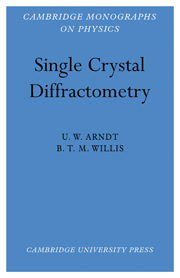Book contents
- Frontmatter
- Contents
- Preface
- CHAPTER 1 Introduction
- CHAPTER 2 Diffraction Geometry
- CHAPTER 3 The Design of Diffractometers
- CHAPTER 4 Detectors
- CHAPTER 5 Electronic Circuits
- CHAPTER 6 The Production of the Primary Beam (X-rays)
- CHAPTER 7 The Production of the Primary Beam (Neutrons)
- CHAPTER 8 The Background
- CHAPTER 9 Systematic Errors in Measuring Relative Integrated Intensities
- CHAPTER 10 Procedure for Measuring Integrated Intensities
- CHAPTER 11 Derivation and Accuracy of Structure Factors
- CHAPTER 12 Computer Programs and On-line Control
- APPENDIX: Summary of differences between X-ray and neutron diffractometry
- References
- Index
CHAPTER 7 - The Production of the Primary Beam (Neutrons)
Published online by Cambridge University Press: 21 May 2010
- Frontmatter
- Contents
- Preface
- CHAPTER 1 Introduction
- CHAPTER 2 Diffraction Geometry
- CHAPTER 3 The Design of Diffractometers
- CHAPTER 4 Detectors
- CHAPTER 5 Electronic Circuits
- CHAPTER 6 The Production of the Primary Beam (X-rays)
- CHAPTER 7 The Production of the Primary Beam (Neutrons)
- CHAPTER 8 The Background
- CHAPTER 9 Systematic Errors in Measuring Relative Integrated Intensities
- CHAPTER 10 Procedure for Measuring Integrated Intensities
- CHAPTER 11 Derivation and Accuracy of Structure Factors
- CHAPTER 12 Computer Programs and On-line Control
- APPENDIX: Summary of differences between X-ray and neutron diffractometry
- References
- Index
Summary
Quantitative neutron diffraction studies were not possible until 1945 with the advent of the nuclear reactor as a powerful source of neutrons. A high–flux reactor, such as the Harwell Dido or Pluto research reactors, has a central flux of about 1014 slow neutrons/cm2/sec. These neutrons move in all directions and only a proportion of about 1 in 105 travel in the right direction down the collimator; of these collimated neutrons, in turn, a fraction of between 10−3 and 10−2 has the right wavelength to be reflected by the monochromator. The collimated flux of monochromatic neutrons striking the sample is, therefore, 106 to 107/cm2/sec. This compares with a flux exceeding 1010 quanta/cm2/sec at the sample in the X–ray case. To compensate for this disparity in the incident flux and for the smaller cross–section for scattering of neutrons as compared with X–rays (Bacon, 1962), larger samples are used in neutron diffraction and the time required to count the diffracted neutrons is usually made longer.
In this chapter we shall describe briefly the collimators and monochromators used for the production of the primary neutron beam striking the sample. Only those points are discussed which relate to single crystal diffractometry: other neutron techniques are covered in Chapter 4 of G. E. Bacon's Neutron Diffraction (1962) and in Chapter 3 of Thermal Neutron Scattering (1965), edited by P. A. Egelstaff. In §7.3 on monochromators we include a discussion of the resolution of neutron reflexions, as this is closely connected with the properties of monochromators.
- Type
- Chapter
- Information
- Single Crystal Diffractometry , pp. 198 - 219Publisher: Cambridge University PressPrint publication year: 1966

